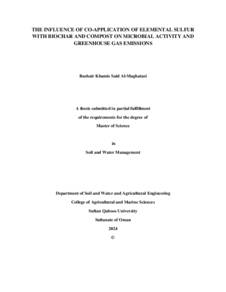وثيقة
The influence of co-application of elemental sulfur with biochar and compost on microbial activity and greenhouse gas emissions.
المصدر
Master's thesis
عناوين أخرى
تأثير تطبيق الكبريت مع الفحم الحيوي والأسمدة العضوية على النشاط البكتيري وانبعاثات الغازات الدفيئة في التربة
الدولة
Oman
مكان النشر
Muscat
الناشر
Sultan Qaboos University
ميلادي
2024
اللغة
الأنجليزية
نوع الرسالة الجامعية
Master's thesis
الملخص الإنجليزي
Controlling the greenhouse gas emissions from agricultural practices has become a popular
topic for environmental researchers to mitigate the effects of climate change. Also, improves
the productivity of the agricultural sector. Thus, the application of soil amendments could
help achieve this goal. This study aimed to evaluate the effect of the co-application of
elemental sulfur with biochar and compost on plant growth, emission of greenhouse gases
(GHG), and soil health and fertility. The experiment was conducted using three different soil
amendments: compost (C), biochar (B), elemental sulfur (S), and their combinations, with a
total of eight different treatments and four replications of each. The emissions of GHG (CO2,
CH4, and N2O) were measured for 90 days using a closed chamber connected to a gas
analyzer device. The chemical properties of soil samples included soil pH, EC, organic matter
content, available phosphorus, total elemental composition, and percentage of calcium
carbonate. For microbiological analyses, different growth media to culture bacteria,
actinomycetes, and fungi were used. In addition, the soil samples were assayed for respiration
rate, microbial diversity by 16S rRNA V4 gene sequencing, and soil enzyme activity,
including urease, dehydrogenase, phosphatase, and fluorescein diacetate hydrolase activity.
The addition of S alone or in combination with compost has been shown to reduce soil pH;
however, the combination of sulfur with biochar buffer reduces soil pH. The addition of
biochar increased the OM in the soil, only about 40% remained after 2 months. However, the
combined application of biochar, compost, and elemental sulfur (S+C+B) resulted in the
highest OM accumulation in the soil (about 46%). In addition, this combination enhances
microbial growth (bacteria, actinomyces, and fungi) and enzyme activities, which ultimately
improve soil health and fertility. The biochar treatments exhibited higher total operational
taxonomic units (OTUs), as well as increased Shannon and Evenness diversity indices,
indicating greater ecological resistance to environmental changes. Based on the niche map
clustering some species show a high abundance in certain treatments. Nitrosovibrio tenuis
has dominated in elemental sulfur treatment which is Ammonia-oxidizing bacteria involved
in the nitrification process, also,this treatment dominated by Thiobacillus denitrificans
(denitrification microbes). Cellvibrio ostraviensis was found to be in high abundance in
compost which carries out the reduction of nitrate to nitrite (contribute to N2O). Results also
showed that the addition of elemental sulfur alone enhanced methanotrophic microbes and
significantly reduced the average emissions of CO2 by 48%, N2O by 94%, and CH4 by 76%,
whereas biochar alone significantly reduced the average emission of two gases CO2 and N2O
by 46% and 70%, respectively, CH4 the reduction was not significant. These findings
underscore the importance of integrated soil amendments in enhancing soil health, and
microbial diversity, and mitigating GHG emissions from agricultural practices, thus
contributing to global efforts in climate change mitigation and sustainable agriculture.
الملخص العربي
تمثل مراقبة انبعاثات الغازات الدفيئة من الممارسات الزراعية موضو ًعا شائعًا وحيويًا بالنسبة للباحثين في مجال البيئة للحد من تأثيرات التغير المناخي. بالإضافة إلى ذلك، يعزز ذلك إنتاجية القطاع الزراعي. لذا، يمكن أن يساعد تطبيق المحسنات على التربة في تحقيق هذا الهدف. هدفت هذه الدراسة إلى تقييم تأثير التطبيق المشترك للكبريت العنصري مع الفحم الحيوي والسماد العضوي )من مصدر نباتي( على نمو النبات وانبعاثات الغازات الدفيئة وصحة التربة وخصوبتها. أجريت هذه التجربة باستخدام ثالث محسنات للتربة وهي الكبريت (S (،الفحم الحيوي (B (والسماد العضوي (C (والخلط بينها بمجموع ثماني مجموعات مختلفة وأربع تكرارات لكل منها. تم قياس انبعاثات الغازات الدفيئة )ثاني أكسيد الكربون 2CO، الميثان 4CH ، وأكسيد النيتروزO2N ) لمدة 90 يو ًما باستخدام وعاء مغلق متصل بجهاز تحليل الغازات. تضمنت تحاليل الخصائص الكيميائية لعينات التربة درجة الحموضة ، الملوحة، ونسبة المواد العضوية، والفوسفور المتاح، والتركيب العنصري الكلي، ونسبة كربونات الكالسيوم. بالنسة لتحليالت البكتيريولوجية، استُخدمت وسائط نمو مختلفة لزراعة البكتيريا، واألكتينوميسيتات والفطريات. باإلضافة إلى ذلك، تم فحص معدل التنفس في التربة، وتنوع الميكروبات بواسطة تسلسل جين 416V rRNA S، ونشاط اإلنزيمات بما في ذلك اليورياز، والديهيدروجيناز، والفوسفاتاز، ونشاط هيدروالز الفلوريسين دي أستات. أظهرت النتائج أن إضافة الكبريت بمفرده أو بالمزيج مع السماد العضوي تساهم في التقليل من درجة حموضة التربة، ولكن المزج بين الكبريت والفحم الحيوي يعمل على مقاومة تقليل حموضة التربة. إضافة الفحم الحيوي على زيادة نسبة المواد العضوية في التربة، وبعد شهرين، بقي حوالي %40 فقط منه في التربة. ومع ذلك، أدى التطبيق المشترك للفحم الحيوي والسماد العضوي والكبريت (B + C + S (إلى أعلى تراكم للمواد العضوية في التربة )حوالي %46(. باإلضافة إلى ذلك، أظهرت النتائج أن هذا التركيب يعزز نمو الميكروبات )البكتيريا، واألكتينوميسيتس، والفطريات( وأنشاط اإلنزيمات المختلفة، مما يحسن في النهاية صحة التربة وخصوبتها. أظهرت النتائج أن الفحم الحيوي يحتوي على أعلى إجمالي وحدات التصنيف التشغيلية (OTUs (تنوع شانون )Shannon (افنس (Evenness (مما يدل على القدرة علي مقاومة أكبر للتغيرات البيئية. وبنا ًء على خريطة التجمعات البيئية، يظهر بعض األنواع البكترية وفرة عالية في بعض المعالجات. حيث سادت بكتيريا tenuis Nitrosovibrio في معالجة الكبريت، والتي تُعتبر نوع من البكتريا القادر على اكسدة األمونيا المتضمنة في عملية النترة، وأي ًضا، بوجود Thiobacillus denitrificansوالتي تعتبر ميكروبات اإلزالة النترات. تم العثور على ostraviensis Cellvibrio في كميات كبيرة في السماد العضوي الذي يُنجز تخفيض النترات إلى النيتريت )يساهم في انبعاث O2N) . أظهرت النتائج أيضا أن إضافة الكبريت بمفرده عزز الميكروبات الميثانوتروفية ) methanotrophic )وخفض بشكل ملحوظ متوسط انبعاثات 2CO بنسبة ،%48 O2Nبنسبة ،%94 و 4CH بنسبة ،%76 بينما اظهر الفحم الحيوي بمفرده على قدرته في تقليل انبعاثات متوسطة للغازين 2CO و O2N بنسبة %46 و %70 على التوالي. تسلط هذه النتائج الضوء على أهمية اضاقة المحسنات المتكاملة على التربة في تعزيز صحة التربة وتنوع الميكروبات، والحد من انبعاثات الغازات الدفيئة من الممارسات الزراعية، مما يسهم في جهود التغير المناخي والزراعة المستدامة عالميًا.
قالب العنصر
الرسائل والأطروحات الجامعية

